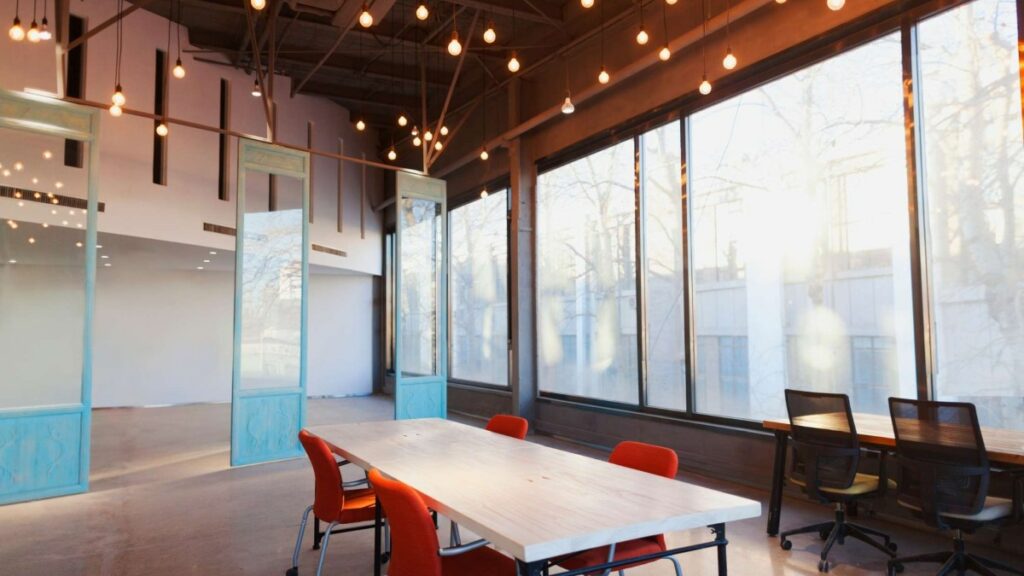Nowadays, everyone is wondering about what the future workplace will look like. The millennial generation is taking over the global workforce, and their preferences are giving birth to new trends.
Remote work is becoming more relevant by the day in the business world. People who work remotely have the option of working from home or another place of their choice. However, work from home no longer appeals to everyone.
Lack of human interaction and being detached from the happenings in the office reduces employee morale, productivity, and overall performance.
Coworking spaces are the answer to this, and they have the best of two worlds. That is why a majority of freelancers prefer coworking spaces instead.
Future coworking trends
With remote work being more important than ever, coworking spaces stealing the show once again, here are a few most important future coworking trends.
1. The rise of remote work
Remote work isn’t a new trend. It has been around for some time now. However, the global pandemic forced numerous companies to switch to remote work quickly. That way, these companies could remain operational even during a crisis.
As it turns out, there was a dramatic increase in remote work. About 20% to 25% of the workforce could work remotely from three to five days a week. Many companies realized the benefits of remote work and are planning to shift towards a more flexible work environment.
Some companies planned to adopt a more permanent remote-working model, while other companies planned to adopt hybrid models.
Here’s a complete guide about hybrid vs remote work.
Moreover, a lot of people were left unemployed due to the pandemic. It’s estimated that 28% of workers will need to completely change their occupations by 2030.
Due to the uncertainty caused by the pandemic, people are focusing on the freelance sector and contingent workforce. Being able to work from home is the top criterion for people who are looking for employment.
But where do coworking spaces fit into all of this? As the number of remote workers skyrockets across the world, the demand for coworking spaces will increase as well.
According to statistics, it’s estimated that the number of worldwide coworking spaces will increase from 20,000 in 2020 to 40,000 by 2024.
There are already many popular ones, such as coworking spaces in Phoenix, Denver, Nashville, and so on, but there will definitely be even more in the near future.
Moreover, it’s also estimated that around 5 million people will be working from coworking spaces by 2024. This is an astonishing 158% increase compared to 2020.
2. Pros and cons of remote work
The reason why so many companies failed to acknowledge the benefits of remote work is that they had a biased opinion.
Companies fail to realize how important work flexibility really is. They like to have a tight grip around everything that’s going on in the office. That way, they can control the situation as they see fit.
If your employees are working from home or in a coworking space, then you can’t keep an eye on them at all times. However, when companies were forced to leverage remote work, they finally realized its true value.
Remote work isn’t the best solution, but it’s a great one. There are pros and cons you must be aware of if you plan on utilizing remote work’s full potential.
Pros of remote work
- More flexibility.
- Higher employee productivity, morale, and performance.
- Reduced overhead costs on office space and supplies.
- Technology allows high connectivity for remote workers.
Cons of remote work
- Employees face more distractions at home.
- Employees can feel isolated, which reduces their morale and motivation.
- Poor planning leads to employee disengagement.
- Possibility of high turnovers.
That’s why more companies invest in coworking spaces. That way, they can still leverage remote work and all of its benefits while minimizing the downsides.
3. Automated coworking spaces
Technology powers everything today, and coworking spaces are no exception. When you have a coworking space, you also accommodate a lot of people from various industries who all have unique preferences.
You simply cannot cater to each individual’s needs. Some are early birds and prefer to come in early in the morning. Others, on the other hand, are night owls and prefer to work during the night. If you regulate when people come and go, you’re most likely to lose clients.
That’s why coworking spaces are available to people 24/7. However, this is a potential problem for the owners of the offices. You have to hire people to work day and night to make sure there’s always someone present at the office.
This just boosts operational costs and is not viable. Instead of hiring people to manage the office, more coworking owners are focusing on tech solutions. Now there’s a trend of having fully automated coworking space available to every member at any time.
Technology-driven management solutions consist of access cards, specialized software, surveillance, and user protection, among other things.

Basically, you can come in at 3 in the morning, and you can access your office space while other offices are safely locked away. Technology makes coworking spaces not only practical but also safe.
4. Coworking spaces and marketing
Coworking spaces focus on acquiring long-term customers. You want your members to use your office space and keep using it for years to come. That’s why it’s of vital importance to create a unique and compelling offer.
Today, more and more coworking spaces are promoting themselves online. Digital marketing has become an essential part of that process. Nowadays, every coworking space needs a well-designed website so that potential clients can check everything out before making a decision.
That’s why so many coworking space owners opt for a professional website design agency that can help them create a killer website. If you’re uncertain what your website should contain, here’s a list of a few essential things to help you out.
- Fill your pages with high-quality visual content, such as images and videos.
- Highlight your most prominent features and services.
- Include contact information.
- Have transparent policies and pricing.
- Include a unique selling proposition.
- Have CTAs and social sharing buttons at all the right places.
- Include promotions, discounts and special offers.
Once your website is up and running, you can promote your coworking space across the Internet. That said, you need to have a solid digital marketing strategy that will yield a viable ROI (Return on Investment).
The cost of acquiring new customers may be high, but long-term profits can easily undermine such expenses.
5. Niche-specific coworking spaces
As mentioned before, your coworking space can feature people from various industries. This makes it more difficult to cater to their needs. You cannot choose a specific office design or have a particular range of services. That’s why a lot of coworking spaces are becoming niche-oriented.
What that means is that these coworking spaces are designed for people from the same industry or the same profession. This new trend helps turn coworking spaces into community-based offices where people can not only work together but also collaborate.
When you have people from your profession sharing an office with you, it becomes easier to establish meaningful relationships. That way, you can ask someone for advice or have someone help you brainstorm different ideas.
As for the owners of the coworking space, it’s easier to manage such areas. Moreover, it’s also easier to meet the needs of your customers when everyone, more or less, shares the same preferences. It’s also easier to provide customers with digital support when they all share common needs and expectations.
Furthermore, niche-specific coworking spaces don’t necessarily mean people in the same profession or industry. Some niche coworking spaces have taken a step further. Here are a few interesting examples.
- Female-only coworking spaces.
- Coworking spaces for parents.
- Coworking kitchens.
- Coworking spaces for entrepreneurs in the pet supply business.
6. Improving coworking space design

One of the most important trends in the coworking industry is office space design improvement. The purpose of coworking spaces shifted from being convenient offices for remote workers and freelancers to stress-free environments.
Therefore, it’s more than just an office space. In fact, it’s a place where you can relax and enjoy yourself while getting some work done in the process. That’s why design matters. Owners of such spaces want to create an environment that everyone will like.
Of course, you cannot know the individual design preferences, but you can create something everyone will enjoy.
Many coworking space owners even conduct a bit of research among their customers to determine their preferences. That way, they can create an ideal atmosphere that has a bit of everything for everyone.
That said, workspaces have come a long way from stress-inducing cubicles to offices that don’t even look like offices anymore.
Such places help people boost their motivation, performance and productivity. That’s why so many remote workers opt for coworking spaces instead of working from home.
7. Mobile coworking spaces
One of the most interesting and most popular trends in the coworking industry is mobile coworking spaces. As you may already know, there are a lot of digital nomads these days. These people decided to work remotely and travel the world while at it.
This is a great way to have a job and enjoy every moment of it. Mobile coworking spaces are designed to help traveling remote workers settle down somewhere to do their work while resuming their travels. This is simply the best example of work flexibility.
So what exactly are mobile coworking spaces? As you might imagine, these are usually buses, trailers and mobile pods redesigned into coworking spaces on wheels. This trend has only started to gain momentum.
So far, you have mobile coworking spaces that take you from the noisy city environment to the serene nature ambient. In the future, there are possibilities of coworking spaces that travel to different countries and even continents.
For digital nomads and traveling remote workers, this is a big thing and a trend worth looking out for. Who knows, this trend may redefine both remote work and modern workplaces as we know it.
8. Traditional industries switching to coworking spaces
As mentioned before, the global pandemic has forced a lot of companies to rely on remote work.
Employees who had an opportunity to work from home aren’t willing to go back to the office anymore. You’d be surprised just how dissatisfied people are with working from a company office.
In fact, 75% of workers would give up one of their work benefits for an opportunity to choose their work environment. These benefits include healthcare coverage, cash bonuses, and even paid time off. These are all benefits that shouldn’t be taken lightly.
Still, people are willing to sacrifice those benefits for the freedom to choose their work environment. This is a huge trend, indeed, with the potential to reshape work in the post-pandemic period. Experts suggest that this trend would’ve developed on its own eventually.
However, the pandemic rapidly accelerated things, and it has caught companies off-guard. Now, even traditional industries are considering a shift towards remote work and coworking spaces. The main reason is that such companies see this trend as an opportunity.
After all, companies want to be perceived as modern businesses so that they can attract younger talents.
Make no mistake; these companies have profits in mind. By shifting to coworking spaces, they can reduce costs and increase profits. It seems that this trend benefits both companies and future employees.
9. Hybrid coworking spaces
It’s evident that coworking spaces are evolving at a rapid pace. They are further distancing themselves from traditional offices and turning themselves into something entirely different. This is no longer about the design or technology used.
In fact, it’s about a variety of services that modern coworking spaces provide. This gave birth to a hybrid coworking space trend that keeps getting more and more popular these days. A good example is a coworking space and gym hybrid.
People can book desks to do their work and even opt for a gym membership. That way, they can include regular exercise as part of their daily routine. Some coworking spaces have turned into social centers as well.
Here people can engage in networking events, seek new employment, meet a mentor, and so on. Innovative and creative ideas are reshaping coworking spaces. That and the benefits of co-economy where two or more businesses can benefit greatly from their collaboration.
It’s likely that we’ll see more of these hybrid coworking spaces in the future. This approach seems to work nicely and it encourages people to use coworking spaces more frequently.
10. Multi-location coworking spaces
Another trend that’s taken the coworking industry by storm is multi-location operations. That said, there’s a high demand for multiple coworking space locations. People may get bored of one office space and may want to go to another.
A change in the environment is always beneficial, but that doesn’t mean that people want to change service providers. Therefore, coworking operators are technically forced to either open multiple locations or even expand globally.
This is especially true if you have a lot of members who prefer to work and travel. The main reason this is beneficial is that it allows coworking businesses to grow.
Moreover, it helps them build customer loyalty as you basically accompany your members on their travels. On the other hand, your members can expect the same range of services and amenities across multiple locations in the world.
11. Preparing for the hybrid workforce
As mentioned before, companies want people in the office while employees want to work remotely. Experts suggest that a compromise will have to do. This is likely to create a hybrid workforce that will work partially in the office and partially remotely.
This trend will also most likely affect coworking spaces in one way or another. That said, coworking operators should be prepared for this upcoming trend. In other words, you should prepare to transform your flexible coworking space into an amenity that will meet company needs.
By partnering up with a company, you’ll be able to meet the needs of their hybrid workforce. That said, their employees will need a reliable office space every now and then.
They may also need your coworking space for business meetings, team-building activities, and so on. Therefore, it doesn’t hurt to prepare for the upcoming change in the business world and capitalize on an opportunity that presents itself.
Conclusion
The future of coworking spaces has changed dramatically in just over a year. The global pandemic has caused major disruptions that accelerated changes faster than anyone could’ve predicted.
These changes have also accelerated coworking trends that were slowly developing on their own. Nevertheless, the changes have happened and there’s no going back. Now it’s time for everyone to adapt to the new normal.

Travis Dillard is a business consultant and an organizational psychologist based in Arlington, Texas. Passionate about marketing, social networks, and business in general. In his spare time, he writes a lot about new business strategies and digital marketing for DigitalStrategyOne.


